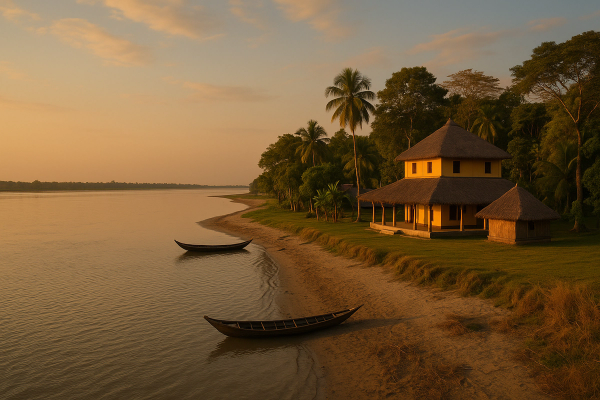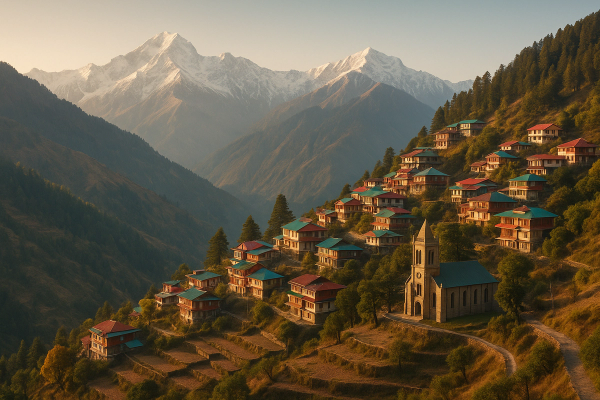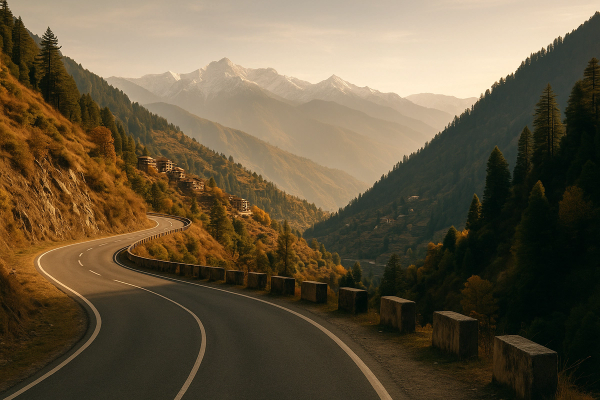Best Hill Station Workspaces for Digital Nomads in India (2025 Field Notes You Can Actually Use)#
India’s hill stations are where laptops meet cedar forests, cold brew meets cardamom chai, and your Monday morning stand-up call suddenly has Himalayan peaks in the background. If you’re plotting a workation or a longer remote stint in 2025, this field guide pulls together what digital nomads and operators on the ground keep reporting as the real, workable options—places where the Wi‑Fi holds up, the vibe is right, and your budget doesn’t melt faster than a summer snowcone. Conditions in mountain regions shift with seasons and infrastructure projects, so double-check local updates right before you go.¶
2025 quick-brief: visas, internet, safety, and costs#
- Visas: India does not offer a dedicated digital nomad visa as of 2025. Most remote workers enter on the e-Visa (tourist) and work online for a foreign employer. Confirm eligibility and rules at the official Indian Visa Online portal; e‑Visa options typically include 30‑day, 1‑year, and 5‑year tourist variants for many nationalities. Policies can change quickly for specific countries, so verify your status and duration before booking. Overstays are costly—don’t risk it.
- Work legality: Doing remote work for a foreign company while in India on a tourist e‑Visa is generally tolerated, but you’re not allowed to work for or earn income from an Indian entity without the appropriate visa. If you plan long multi-month stays, consult an immigration professional and keep any registration requirements (if you ever transition to longer-term visas) on your radar.
- Connectivity: Jio and Airtel dominate. 4G is widespread; 5G has reached many tier‑2 towns and some hill hubs (Shimla, Dehradun, Dharamshala-Manali corridors see expanding coverage). Mountain valleys can be patchy. Travel with dual SIM or an eSIM from a reputable provider, and bring a power bank. Internet cafes are rarer; co‑living/hostel cowork rooms and cafes with strong routers are the norm.
- Season and safety: Monsoon (roughly June–September, varying by region) can trigger landslides and periodic road/rail closures across Himachal, Uttarakhand, Sikkim, and the Northeast. In winter (Dec–Feb), snow can shut mountain passes and knock power. Always check state PWD/tourism/X handles for road advisories and keep flexible itineraries. Get travel insurance that explicitly covers weather-related disruptions.
- Permits: Foreigners require an Inner Line/Protected Area Permit for specific zones (e.g., parts of Sikkim, areas near international borders). Sikkim’s ILP is typically straightforward when entering by road from West Bengal, but protected areas like North Sikkim have extra restrictions. Carry physical ID copies; checkpoints are common.
- Costs (typical ranges in 2024–2025): Coworking day passes in smaller hill towns run roughly ₹300–₹800; monthly desks ₹5,000–₹10,000. Co‑living/hostel dorm beds with work zones: ₹800–₹1,800 per night; private rooms in decent guesthouses ₹2,000–₹4,500; boutique stays ₹5,000+. Third‑wave coffee ₹180–₹300; basic thali ₹150–₹250. Card and UPI are widely accepted, but carry some cash for remote villages.
Dharamkot & McLeod Ganj (Dharamshala, Himachal) — pine trees, Tibetan cafes, and real work rhythms#
This is one of the most consistent hits for remote workers who want a walkable town with mountain views and cafe culture. The Dharamkot–McLeod belt blends mellow neighborhoods, yoga studios, and serious caffeine. Co‑living hostels and stays often advertise “work-friendly” lounges, and several cafes are known to be laptop-tolerant during weekdays. Expect solid 4G, with 5G peeking in closer to Dharamshala town and along main arteries. Power outages happen during storms, so choose a stay with backup power and confirm router uptime. Popular all‑day cafes can get busy mid‑season; early mornings are prime for focus. Illiterati Cafe near McLeod remains a beloved spot for views and reading breaks; in Dharamkot, you’ll find scene-y coffee bars with reliable routers, but always speed-test on arrival. Best weather windows: late March–June and October–November. Summer brings crowds; monsoon brings mud and moody skies but also discounts.¶
Bir (Himachal) — small-town, big sky, paraglider central, quietly productive#
Bir is compact, breezy, and known for paragliding, which means seasonal buzz but a generally chill tempo that suits long, deep work sprints. The Tibetan Colony and the stretch toward the landing site host a cluster of cafes with plug points and decent Wi‑Fi; several hostels and boutique stays market proper cowork lounges. Across reports, speeds are fine for calls outside of peak usage hours; upload can dip in rain. Power cuts still crop up—ask about inverters. Food is excellent and varied (momos, thukpa, sourdough, vegan bowls). Off-season (post-monsoon into Nov) is magic: crisp air, long walks, and calm weekdays. If you’re noise-sensitive, avoid peak flying festivals when launch/landing chatter carries. Budget travellers find great value: dorms with cowork areas around ₹900–₹1,500; private rooms from ~₹2,200. Night buses from Delhi arrive near sunrise; the Kangra airport (Dharamshala) is the nearest flight link.¶
Manali, Old Manali, and Naggar/Tirthan side quests — pick your flavor of mountain hustle#
Manali is the blockbuster. Old Manali has that classic river-and-pine postcard look, with cafes that tolerate laptops but can get loud. If your work is call-heavy, consider stays that explicitly provide quiet rooms and backup. Several coliving brands operate around Old Manali and on the way to Vashisht; you’ll also find cowork areas in boutique hostels (check for dedicated desk space and stable chairs, not just lounge seating). For a gentler pace, base in Naggar (about an hour from Manali) and pop into the big town for errands. Tirthan/Jibhi (further south-west) have soared in popularity—expect beautiful cedar valleys and homestays with fast-enough Wi‑Fi, but do verify speeds valley by valley. Monsoon landslides and winter snow can pinch travel; NH‑3 sees periodic blocks. Cafe 1947 is iconic riverside hangout in Old Manali—great for evenings, not always ideal for serious upload. Price snapshot: day passes ₹400–₹700 where available; private rooms with decent work desks ₹2,500–₹4,500 mid‑season.¶
Uttarakhand’s circuit: Mussoorie/Landour, Bhimtal/Mukteshwar, and Kasar Devi (Almora)#
Uttarakhand is about greener slopes, gentler hikes, and cottage-style stays. Mussoorie (and the quieter Landour ridge) pair well with Dehradun’s transport links—there’s a Vande Bharat train from Delhi to Dehradun that slashes travel time, then it’s a scenic drive uphill. In Mussoorie/Landour you’ll find cozy cafes, fresh bakes, and boutique hotels that quietly welcome laptops between breakfast and the evening rush. Up in Kumaon, Bhimtal/Mukteshwar deliver lake views and orchard homestays with ample daylight and verandas that double as offices. Kasar Devi near Almora draws creatives and remote workers looking for long-stay rentals and slower mornings; the stargazing is exceptional when skies are clear. Connectivity ranges from good 4G on ridgelines to “walk to the balcony for signal” in valleys—ask hosts for recent speed tests. Expect monkeys around Landour and Mahasu areas; keep snacks sealed. Budget: private rooms ₹2,200–₹4,000; longer monthly deals can dip below ₹1,800/night equivalent.¶
Shillong (Meghalaya) and Gangtok (Sikkim) — eastern freshness with extra paperwork#
Shillong blends colonial-era lanes, indie music, and cloud forests. Cafe culture is lively; power and internet are decent in town, though heavy rains can slow speeds. The airport at Umroi has limited connections, so many fly into Guwahati and road-trip up (3–4 hours depending on traffic). Shillong gets serious rain—carry waterproofing for your gear and plan buffer days. Farther north, Gangtok in Sikkim offers crisp mountain air and structured urban amenities; MG Marg is the pedestrianized heart with coffee, bakeries, and views. Foreigners typically need an ILP to enter Sikkim by road; arrange it in advance or at the checkpost as rules allow, and remember that protected areas (like North Sikkim beyond Mangan) need extra permits and often disallow foreigners entirely. Internet: 4G is standard; 5G is expanding in bigger hubs but don’t rely on it. Stays with routers on UPS/inverters are your friend. Food is a highlight—noodles, fermented bamboo shoot, momos, local teas. Expect private rooms ₹2,500–₹5,000 and limited coworking-only venues; most work happens in cafes or stay lounges.¶
South India’s green desks: Wayanad, Coorg (Kodagu), Chikmagalur, and Munnar#
If you want fewer altitude swings and more evergreen plantations, the southern hills deliver outrageous balcony offices. Wayanad (Kerala) is a network of forested ridges with homestays that often include quiet study rooms; 4G is strong near towns, patchy deeper into estates. Coorg (Kodagu, Karnataka) centers on Madikeri, with third-wave coffee, homely bakeries, and villa stays bundled with local beans and wide tables—the dream setup if your work is long-form or design-heavy. Chikmagalur’s coffee estates have upped their game with decent routers and backup power, though you should still ask about downtime during storms. Munnar (Kerala) is scenic but monsoon-prone; power stability varies, so vet carefully if your meetings are mission-critical. Nearest airports: Kannur for northern Kerala/Kodagu, Mangalore for Chikmagalur/Coorg, and Kochi for Munnar/Wayanad (south-east sections). Costs float around ₹2,500–₹5,500 for comfortable private rooms; bungalows and villas are more. Leeches in peak monsoon—bring proper socks if you’ll wander.¶
Srinagar and Gulmarg (Jammu & Kashmir) — stunning, with extra caution and winter prep#
Srinagar’s Dal Lake mornings and chinar-lined boulevards are hard to beat visually, and Gulmarg’s meadows and winter snowfields feel otherworldly. Tourism has rebounded in recent seasons, and connectivity in Srinagar city is generally workable for routine calls and uploads. That said, J&K requires a more conservative risk posture in 2025: always check current advisories, avoid large gatherings, and keep embassy/state tourism updates bookmarked. In winter, snow can cut power and roads; portable hotspots and power banks aren’t optional. Co‑working spaces are limited, so most productivity comes from hotel lounges and boutique stays—call ahead for speed tests and generator details. Prices run higher mid‑winter and in summer rush; plan early and build buffers into your calendar for weather or security-related delays.¶
Shimla & Mashobra — classic colonial ridge with new‑school bandwidth#
Shimla wins on access (buses, cabs from Chandigarh; Kalka–Shimla toy train when conditions allow) and on urban amenities at altitude. The core ridge is touristy, but step toward Mashobra or Shoghi for quieter neighborhoods where boutique stays offer dedicated desks. 5G trials and rollouts have improved speeds in and around town, but old buildings can have spotty internal wiring—ask hosts if the router sits in your wing. Monsoon brings slick stairs and occasional slides on approach roads. Winter is charming and cold; power cuts are shorter than in remote valleys, but backups still matter. Pricing spans hostel dorms from ₹900 upward to heritage hotels over ₹6,000; midrange business-friendly stays sit around ₹3,000–₹5,000.¶
Where the community keeps finding reliable work-friendly stays#
Instead of chasing a single brand, look for patterns: hostels and boutique hotels that advertise cowork lounges, ergonomic seating, and router backups are often safer bets than generic guesthouses. Chains like Zostel, The Hosteller, goSTOPS, and “Alt Life” properties frequently kit out communal spaces for laptop users in hill hubs like Manali, Dharamkot, Bir, and Kasol. Independent homestays in Tirthan/Jibhi, Mukteshwar, and Coorg increasingly mention “workation” in their listings—message hosts for actual speed screenshots and power backup details. If you need printers, quiet phone booths, or external monitors, check city-adjacent towns (Dehradun for Mussoorie, Dharamshala proper for McLeod). Whatever you book, confirm: desk height, chair type, number of plugs, inverter/genset capacity, and quiet hours.¶
Internet, SIMs, and backup plans that keep calls from dropping#
- Carry dual SIM if possible: Jio + Airtel covers most bases in the hills. eSIMs are easily activated in major cities; physical SIMs require ID and a passport photo. Activation can take a few hours to a day. - Speed test every new cafe or lounge (Ookla, Fast, Cloudflare). Upload is the meeting-melter—below 2 Mbps gets risky for video. - Power: a 20,000 mAh bank is the minimum. Ask if your stay’s router is on the same backup as the lights. - Offline-first workflow: sync files for times when the rain laughs at your bandwidth. - Schedule calls in late morning when speeds tend to stabilize after the early rush and before evening streaming peaks.¶
When to go — the mountain calendar for getting stuff done#
- Spring to early summer (late March–June): Clear skies, mild to warm days, popular in Himachal and Uttarakhand. Book early, especially around May. - Monsoon (roughly June–September, varies by region): Lush, beautiful, discounted stays, but landslides and outages are more likely. Good for heads-down coding/writing if your deadlines are flexible. - Post-monsoon (October–November): Crisp air and steady sunsets—often the best mix of stability and price. - Winter (December–February): Northern hills can see snow, making travel (and power) dicey in smaller villages; southern hills (Coorg, Chikmagalur, Wayanad) are ideal for cool, stable work blocks.¶
Transport hacks — getting up the hill without losing a day of work#
- Fly as close as practical, then road: Kangra (Dharamshala) for McLeod/Bir, Kullu–Bhuntar for Manali (fewer flights, more weather sensitivity), Dehradun for Mussoorie/Landour, Bagdogra for Gangtok, Srinagar for Kashmir hubs, Kochi/Mangalore/Kannur for the southern hills. - Trains: The Delhi–Dehradun Vande Bharat is fast and comfortable, and saves a workday compared to overnight buses. For Shimla, the Kalka–Shimla narrow-gauge is scenic; landslides can disrupt service during monsoon. - Buses: Himachal Road Transport and private Volvos cover night routes to Dharamshala/Manali/Shimla. Pick seats away from the rear if you need sleep before a meeting. - Last-mile cabs: Pre-book, share your live location, and travel in daylight in monsoon or snow season if you can.¶
Money, meals, and staying well while you work#
UPI payments are ubiquitous in towns, but carry ₹2,000–₹5,000 cash for outlying villages and roadside tea. Cafe menus in hill stations lean on momos, thukpa, parathas, and increasingly, sourdough and single-origin coffee. If you’re doing long calls, pick places with less foot traffic mid-day and confirm their stance on laptops; some coffee bars rotate “no laptop” windows during peak hours. Hydrate—mountain air is dry even when it’s cool. Sunscreen and layers are non-negotiable. In monsoon, wear grippy shoes; in winter, keep a small humidifier or saline spray if your throat gets scratchy. Always filter or boil water if your stay can’t confirm purification.¶
Community and etiquette — being a good guest in the mountains#
Respect quiet hours in small villages; sound carries at night. Ask before flying drones. Keep trails litter-free and go low-plastic—local waste systems are fragile. Consider cowork passes or a coffee/meal every 2–3 hours if you settle in at a cafe with your laptop. In guesthouses, tip housekeeping weekly, not just at the end, so teams can share it fairly. If you’re long-staying, buy groceries and staples locally rather than shipping everything from a metro—it matters.¶
Sample weekly budgets (work-focused, single traveller)#
- Himachal/Uttarakhand midrange: Private room with backup power and strong router ₹2,800–₹4,200 per night; food and coffee ₹800–₹1,500 per day; local transport (cabs/buses) ₹300–₹800 per day averaged; cowork day passes 2–3x a week ₹500 each. Rough weekly total: ₹24,000–₹38,000. - Budget mode with a dorm: Dorm bed ₹900–₹1,500 per night; cook some meals and lean on thalis; weekly total can sit around ₹12,000–₹18,000 depending on moves. - Southern hills midrange: Private rooms trend slightly higher for estates; expect ₹30,000–₹45,000 for a focused week including a couple of cafe splurges and one intercity transfer.¶
Shortlist: where to start if you have one month and a laptop#
- Two weeks Dharamkot/McLeod: settle into a cafe rhythm, do a weekend hike to Triund or a shorter forest loop, and test a couple of coliving lounges. - One week Bir: deep work sprints, paraglider sunsets, and quiet streets; move lodgings once to compare neighborhoods. - One week either Naggar (near Manali) or Kasar Devi (near Almora): slower mornings, balconies with pine or valley views, and fewer tourists mid-week. If monsoon looms, pivot to Coorg or Wayanad for steadier power and quieter rain.¶
What can change fast in 2025 — keep an eye on these before you book#
- Road conditions during monsoon or after heavy snowfall. - Any temporary restrictions or advisories in Kashmir and border-adjacent regions. - Permit rules for Sikkim’s protected areas. - Seasonal “no laptop” policies in crowded cafes. - SIM activation norms and eSIM availability with specific carriers in smaller towns. Official state tourism handles and local district police/Tourism X accounts are surprisingly responsive with closures and detours. Hosts who proactively share speed tests, power backup specifics, and neighborhood noise patterns are worth their rate.¶
Bottom line — pick altitude for your brain, not just your Instagram#
If you need predictable calls and clean commutes to amenities, choose Shimla–Mashobra, Dharamkot/McLeod, or Mussoorie/Landour. If you want deep-focus weeks and calmer streets, Bir, Naggar, or Kasar Devi shine. For rain-drenched, green productivity with fewer power dramas, the southern hills (Coorg, Chikmagalur, Wayanad) deliver. Build buffers around monsoon and winter, budget for a couple of cowork day passes a week, and keep your rig light and redundant. The magic of India’s hill stations is that your lunchtime stretch can be a ridge walk under deodars—and your calendar can still stay green.¶
Final travel thoughts#
India’s mountains reward the prepared: two SIMs, a backup plan, and a flexible calendar get you 90% of the way to a dreamy, functional work week with cool air and long horizons. If you’ve got a specific hill town in mind, compare two neighborhoods, not just two properties—the micro-location (sun exposure, noise, cell tower line‑of‑sight) can make or break your week. For more trip ideas and nitty‑gritty guides, AllBlogs.in keeps a steady stream of on-the-ground travel content that’s useful when you’re sketching out the next workspace with a view.¶














